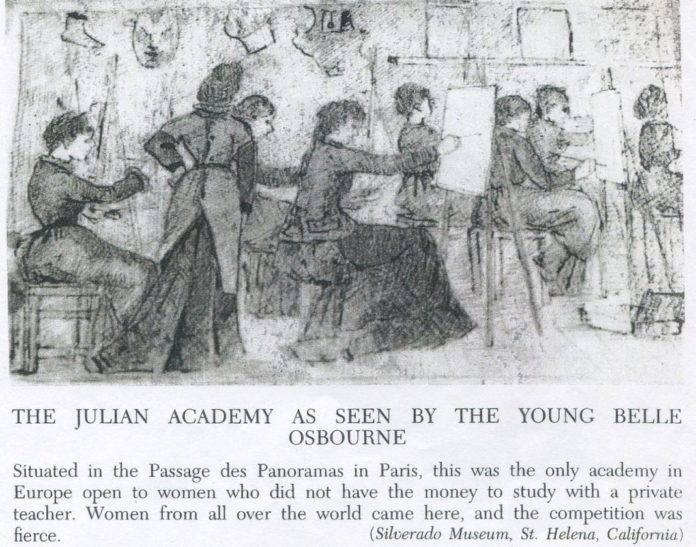
<!–
“So here for the first time Stevenson saw the woman whom Fate had brought half-way across the world to meet him. He straightway fell in love; he knew in his own mind, and in spite of all dissuasions and difficulties, his choice never wavered. The difficulties were so great and hope so remote that nothing was said to his parents or to any but three of his closest friends.” — “The Life of Robert Louis Stevenson,” by Sir Graham Balfour
The scene of this meeting is in the garden of Chevillon inn, beside the Loing River as it passes by the quaint French village of Grez on the south side of the beautiful forest of Fontainebleau, so full of history. “These woods have rung to the horns of all the kings of France, from Philip Augustus downward. They have seen Saint Louis exercise the dogs he brought home with him from Egypt; Francis I go hunting with ten thousand horses in his train — and Peter of Russia following his first stag … Here, booted and spurred, and with all his dogs about him, Napoleon met the Pope beside the woodland cross. Here, on his way to Elba not so long after, he kissed the eagle of the Old Guard, and spoke words of passionate farewell to his soldiers …”
(“Fontainebleau,” R.L. Stevenson)
Fontainebleau, the region southeast of Paris, is named for the village and formerly royal forest that comprise it. It was the setting for the golden days of youth enjoyed there by a group of young artists in the 1870s, some of whom wrote about their experience there because it must have been something special. When Robert Louis Stevenson fell in love with Mrs. Fanny Osbourne in the garden by the river, he was already in love with France, increasingly fluent in the language, and in agreement with his friend Will Low that they were “for the first time and in common, enjoying the large liberty of thought and action that in France is vouchsafed the children of the arts.”
France meant freedom. For RLS and his gang from Edinburgh, Scotland, it meant escape from the life-numbing conservatism of “Auld Reekie,” where, according to Stevenson’s cousin Bob, “You must not think at all or act for yourself … Where public profession is manifestly a lie and public manners a formal exaggeration, life becomes a chest with a false bottom.” For Mrs. Fanny Osbourne, France meant freedom and distraction from her wrecked marriage to Sam Osbourne, who was now an ocean and a continent away in San Francisco, California. It was Fanny’s pursuit of art, a new and passionate interest in her life, that had made France her destination, but it was something more specific, like the recent tragic death of her 5-year-old boy Hervey, that had landed her in Grez. Fanny’s surviving children — Isobel “Belle,” 18, and her brother Lloyd, 8 — were with their mother in the garden behind the inn on that fateful evening in July 1876. It was the first page in a story that would take 18 years to play out to the last scene on top of Mount Vaea, half a world away and down under. Lloyd and Belle would be there, too, with their mother.
Lloyd and Belle would come to Saranac Lake, too, in 1917 without their mother, who had died in 1914. They came bearing priceless gifts of memorabilia for the new Stevenson Society’s new little two-room shrine at Baker’s. Belle’s autobiography, “This Life I’ve Loved,” is one of the richest sources of Stevenson lore and as personal as it can get, from the author’s family who shared in his adventures and battles with “Bloody Jack.” Belle’s recollections of three summers at Grez were still fresh in her mind like yesterday when she finally put them on paper, an insider’s view of Bohemia, Parisian style, on the banks of a tributary of the Seine.
About that night in the garden of Chevillons inn, when Robert Louis Stevenson made his dramatic entry and ended up sitting next to her mother, Belle said, “That was the first time I noticed the extraordinary effect that Louis Stevenson made on any company he joined, bringing out the best in everyone. … We, at Grez, felt something of this from the very first, for Louis brought into our lives a sort of joyousness hard to describe. On sunny days we played on the river, our new friend leading the games with gaiety and the zest he put into everything he did. … On rainy days and evenings we amused ourselves indoors with charades or games that involved the writing of verses, drawing of cartoons, and many that we made up ourselves. But the best of all our good times at Grez were the talks … gay, inspiring, electric. Everyone joined in; we discussed art, fashions, religion, history … any subject.
“The painters scorned sunlight, and endless time was wasted waiting for a gray day. Then we would all be off; O’Meara and I in one direction, my mother in another, with Louis carrying her painting outfit. Bob might join one couple or the other, or go by himself. In the late afternoon we would come trailing home, range our wet canvases in a row along the wall in the dining room, and criticize each other’s work which we did with more wit, I am afraid than kindness.”
Belle said that she and O’Meara, Frank O’Meara, went into the woods in a direction other than that taken by her mother and her skinny new, charismatic boyfriend. Frank was Belle’s first heartthrob, and a very talented and colorful fellow with his blue beret and walking stick. “O’Meara promptly tied himself to my apron-strings, or rather, took me under his wing, explaining the universe to me and correcting my speech. He told me that the most important men in the United States at that time were Irishmen, and named them. The North would never have won the war against the South if it hadn’t been for several more Irishmen, and as for Art, Literature and Drama in any country, Ireland led them all. I listened admiringly and believed every word.”
Frank O’Meara, from the town of Carlow in the Republic of Ireland, was 23 when he painted in the woods with Belle, 18, on the outskirts of Grez. Belle continues: “We spent two summers at Grez and part of a third returning to town (Paris) in the autumn when the studios reopened. … I worked very hard those two winters, drawing from the nude at Julian’s. O’Meara, over in the Latin Quarter, was painting at Carolus Duran’s studio (also Bob Stevenson, Will Low, John Sargent, Henry Enfield and Bloomer), but we would meet on Sundays, or an occasional week-day and roam about the most fascinating city in the world. … The art galleries were open to us; we wandered through the Louvre and the Luxembourg, and O’Meara taught me to admire his favorite old masters, especially Velasquez. We poured over the marvelous portraits by Albrecht Durer, and came again and again to stand before Guido’s head of Christ. We sauntered in the lovely old Luxembourg Gardens where the fallen leaves made a golden carpet for our feet. We spent hours in the Museum de Cluny where O’Meara made the days of the Revolution live again for me, pointing out the actual relics of that terrible time. He was a devout Catholic and often led me into the Cathedral of Notre Dame, where after crossing ourselves with holy water, we would light a candle to Saint Anthony, and beg him to postpone the day of parting that we knew was ahead of us.”
To be continued.







